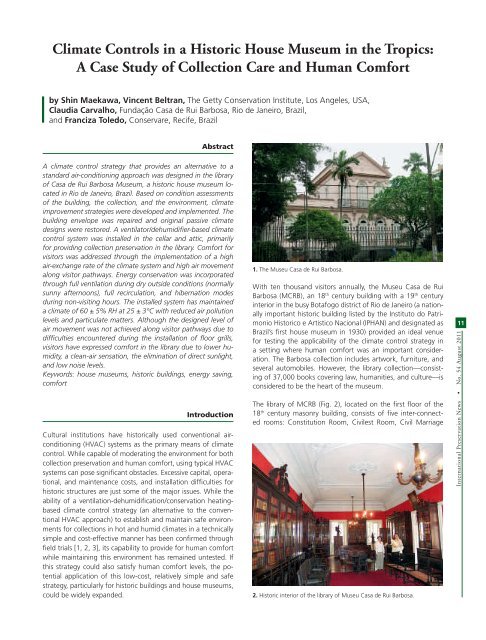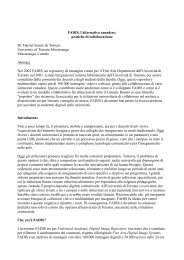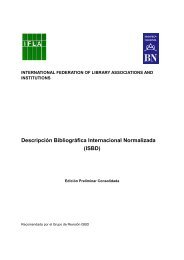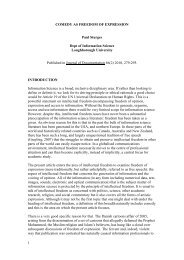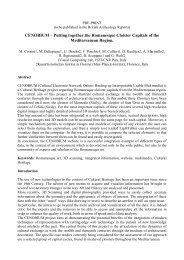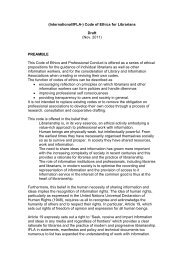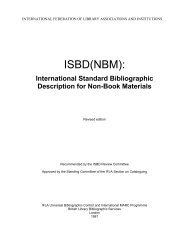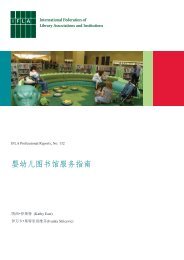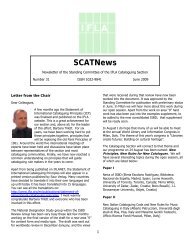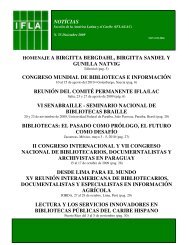N o 54 - IFLA
N o 54 - IFLA
N o 54 - IFLA
You also want an ePaper? Increase the reach of your titles
YUMPU automatically turns print PDFs into web optimized ePapers that Google loves.
Climate Controls in a Historic House Museum in the Tropics:<br />
A Case Study of Collection Care and Human Comfort<br />
by Shin Maekawa, Vincent Beltran, The Getty Conservation Institute, Los Angeles, USA,<br />
Claudia Carvalho, Fundação Casa de Rui Barbosa, Rio de Janeiro, Brazil,<br />
and Franciza Toledo, Conservare, Recife, Brazil<br />
Abstract<br />
A climate control strategy that provides an alternative to a<br />
standard air-conditioning approach was designed in the library<br />
of Casa de Rui Barbosa Museum, a historic house museum located<br />
in Rio de Janeiro, Brazil. Based on condition assessments<br />
of the building, the collection, and the environment, climate<br />
improvement strategies were developed and implemented. The<br />
building envelope was repaired and original passive climate<br />
designs were restored. A ventilator/dehumidifier-based climate<br />
control system was installed in the cellar and attic, primarily<br />
for providing collection preservation in the library. Comfort for<br />
visitors was addressed through the implementation of a high<br />
air-exchange rate of the climate system and high air movement<br />
along visitor pathways. Energy conservation was incorporated<br />
through full ventilation during dry outside conditions (normally<br />
sunny afternoons), full recirculation, and hibernation modes<br />
during non-visiting hours. The installed system has maintained<br />
a climate of 60 ± 5% RH at 25 ± 3°C with reduced air pollution<br />
levels and particulate matters. Although the designed level of<br />
air movement was not achieved along visitor pathways due to<br />
difficulties encountered during the installation of floor grills,<br />
visitors have expressed comfort in the library due to lower humidity,<br />
a clean-air sensation, the elimination of direct sunlight,<br />
and low noise levels.<br />
Keywords: house museums, historic buildings, energy saving,<br />
comfort<br />
Introduction<br />
Cultural institutions have historically used conventional airconditioning<br />
(HVAC) systems as the primary means of climate<br />
control. While capable of moderating the environment for both<br />
collection preservation and human comfort, using typical HVAC<br />
systems can pose significant obstacles. Excessive capital, operational,<br />
and maintenance costs, and installation difficulties for<br />
historic structures are just some of the major issues. While the<br />
ability of a ventilation-dehumidification/conservation heatingbased<br />
climate control strategy (an alternative to the conventional<br />
HVAC approach) to establish and maintain safe environments<br />
for collections in hot and humid climates in a technically<br />
simple and cost-effective manner has been confirmed through<br />
field trials [1, 2, 3], its capability to provide for human comfort<br />
while maintaining this environment has remained untested. If<br />
this strategy could also satisfy human comfort levels, the potential<br />
application of this low-cost, relatively simple and safe<br />
strategy, particularly for historic buildings and house museums,<br />
could be widely expanded.<br />
1. The Museu Casa de Rui Barbosa.<br />
With ten thousand visitors annually, the Museu Casa de Rui<br />
Barbosa (MCRB), an 18 th century building with a 19 th century<br />
interior in the busy Botafogo district of Rio de Janeiro (a nationally<br />
important historic building listed by the Instituto do Patrimonio<br />
Historico e Artistico Nacional (IPHAN) and designated as<br />
Brazil’s first house museum in 1930) provided an ideal venue<br />
for testing the applicability of the climate control strategy in<br />
a setting where human comfort was an important consideration.<br />
The Barbosa collection includes artwork, furniture, and<br />
several automobiles. However, the library collection—consisting<br />
of 37,000 books covering law, humanities, and culture—is<br />
considered to be the heart of the museum.<br />
The library of MCRB (Fig. 2), located on the first floor of the<br />
18 th century masonry building, consists of five inter-connected<br />
rooms: Constitution Room, Civilest Room, Civil Marriage<br />
2. Historic interior of the library of Museu Casa de Rui Barbosa.<br />
11<br />
International Preservation News • No. <strong>54</strong> August 2011


